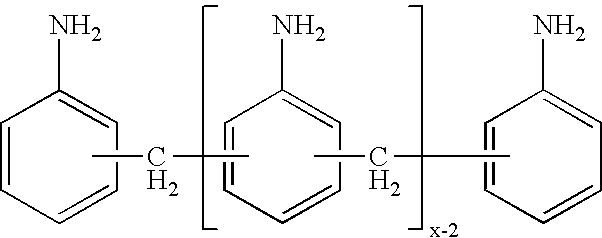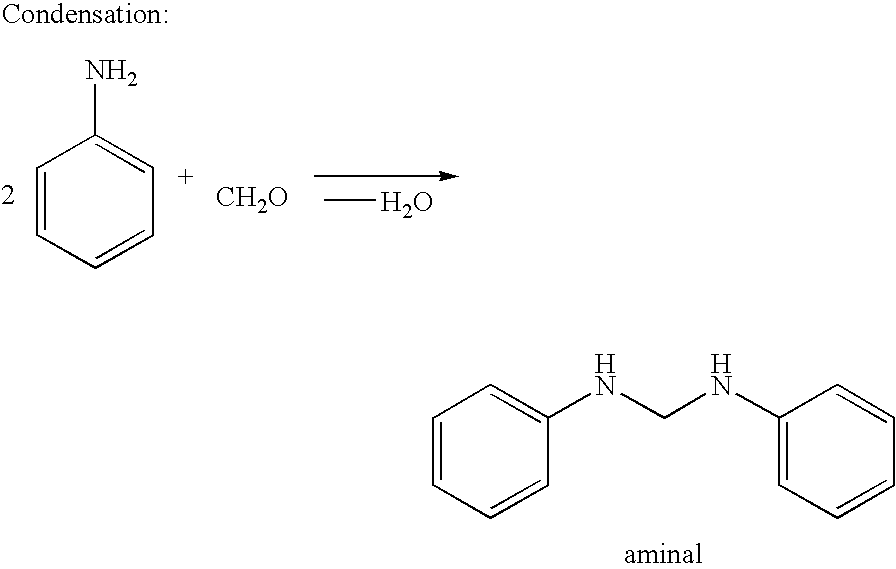Process for the preparation of polyamines of the diphenylmethane series at a low degree of protonation
a technology of diphenylmethane and polyamine, which is applied in the preparation of amino compounds, diaryl/triaryl methane dyes, isocyanic acid derivative preparations, etc., can solve problems such as problems in reaction conductivity
- Summary
- Abstract
- Description
- Claims
- Application Information
AI Technical Summary
Benefits of technology
Problems solved by technology
Method used
Image
Examples
example 1 (
Not According to the Invention, Two-Phase Reaction Mixture)
[0051] 310 g of a 31.7 wt. % strength aqueous formaldehyde solution were added dropwise to 670 g aniline at 80° C. over the course of 20 min, while stirring. After the addition, the mixture was stirred at 80° C. for a further 5 min., and then cooled to 35° C. 83.0 g of a 31.9 wt. % strength aqueous hydrochloric acid were added to the reaction mixture at this temperature, while stirring intensively. The water content of the acid reaction mixture was 30.7 wt. %. Even after heating up to 110° C., the acid reaction mixture was still clearly two-phase, i.e. without the action of a stirrer, dissociation of the acid reaction mixture into an aqueous and an organic phase occured.
example 2 (
Not According to the Invention, Complete Conversion at >110° C.)
[0052] For preparation of the aminal, 334 g of a 32.1 wt. % aqueous formaldehyde solution were added dropwise to 931 g aniline at 80° C. over the course of 20 min, while stirring. After the addition, the mixture was stirred at 80° C. for a further 5 min., and a phase separation was carried out at 70 to 80° C. 900 g of the organic phase, i.e. the aminal, were mixed with 137 g of a 32.0 wt. % aqueous hydrochloric acid at 115° C. over the course of 10 min, while stirring intensively. After the addition of hydrochloric acid, the water content was 12.0 wt. %, and the ratio of p-ABA and 4,4′-MDA was 0.27. After stirring for a further 3 h at 115° C., all the aminobenzylanilines having two rings were reacted. The ratio of 2,4′- and 4,4′-MDA was 0.38. This example demonstrated the effect on the product composition when a complete conversion was achieved at a high temperature of >110° C.
example 3 (
According to the Invention, Majority of the Conversion at 20 to 100° C.)
[0053] The process as described above in Example 2 was followed to yield the aminal. 900 g aminal were mixed with 137 g of a 32.0 wt. % strength aqueous hydrochloric acid at 45° C. over the course of 10 min, while stirring intensively. After the addition of hydrochloric acid, the water content was 12.0 wt. %, and, without the action of a stirrer, the resultant reaction mixture showed no signs of demixing into an aqueous and an organic phase. After the mixture was stirred at 45° C. for 10 min, it was heated up to 80° C. and stirred at 80° C. for a further 60 min. The ratio of p-ABA / 4,4′-MDA was 0.05:1.00. The mixture was then heated up to 115° C. and stirred at this temperature for a further 3 h. Aminobenzylanilines having two rings were no longer detectable, and the ratio of 2,4′- and 4,4′-MDA was 0.14:1.00.
[0054] Compared with Example 2, a clear lowering of the ratio of 2,4′- to 4,4′-MDA was seen, since a larg...
PUM
| Property | Measurement | Unit |
|---|---|---|
| Temperature | aaaaa | aaaaa |
| Temperature | aaaaa | aaaaa |
| Temperature | aaaaa | aaaaa |
Abstract
Description
Claims
Application Information
 Login to View More
Login to View More - R&D
- Intellectual Property
- Life Sciences
- Materials
- Tech Scout
- Unparalleled Data Quality
- Higher Quality Content
- 60% Fewer Hallucinations
Browse by: Latest US Patents, China's latest patents, Technical Efficacy Thesaurus, Application Domain, Technology Topic, Popular Technical Reports.
© 2025 PatSnap. All rights reserved.Legal|Privacy policy|Modern Slavery Act Transparency Statement|Sitemap|About US| Contact US: help@patsnap.com



